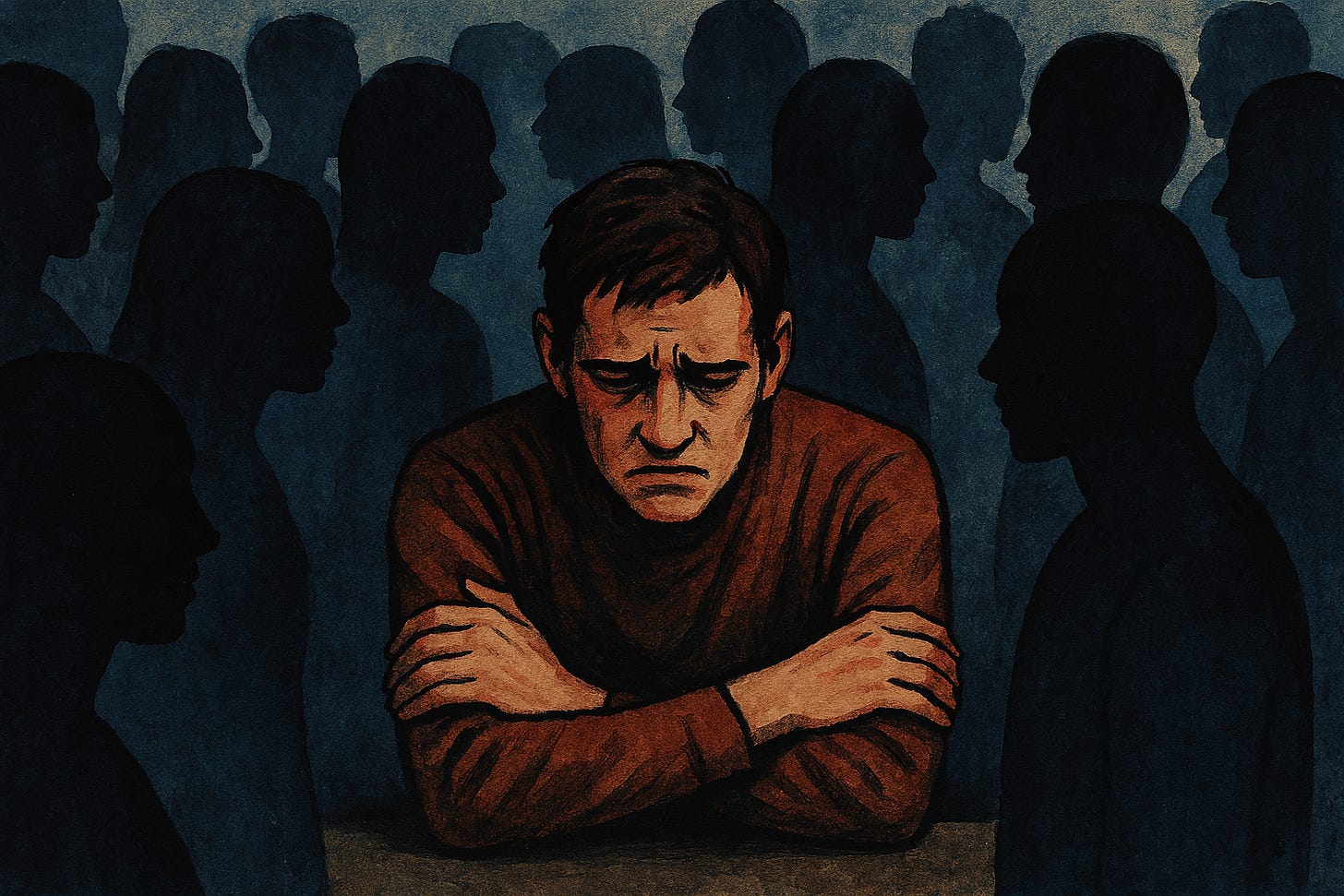Connection Is Medicine, Part 1
Alone in a Crowded World: Why Loneliness Is a Health Risk We Can’t Ignore
A Life Worth Living: Ed’s Story
I have a client — let’s call him Ed — who is well into his nineties. His health goals are modest, but highly personal and very significant: he wants to live independently for as long as possible. He lives alone since his wife passed, but he isn’t truly on his own. Two of his adult daughters live nearby and visit regularly. They bring meals, run errands with him, and, most importantly, sit with him to talk and share time.
I’ve been Ed’s personal trainer for close to a decade, just as I worked with his wife before she passed away. Over that time, the lines between “professional relationship” and friendship faded away. We exercise, yes, but mostly we spend time talking (well, him talking and me listening). More than once I’ve told him I’d be happy to come see him without payment, but he always waves me off. As a former small business owner himself, he insists on paying, saying, “What you give me is worth far more than the couple of bucks I hand you anyway.”
During a recent conversation, Ed told me, “If it wasn’t for my daughters coming by and checking on me, I wouldn’t even be here. They keep me going.”
He’s right. Those connections aren’t an add‑on to his health, they’re the lifeblood of it. While genes, exercise, and medical care all matter, I believe Ed’s secret to thriving into his nineties isn’t found in a prescription bottle or lab value. It’s found in the quality of his relationships.
Ed offers us a living example of something scientists around the world have been trying to measure: how deeply our connections to other people influence not just how long we live, but how well we live.
The Hidden Epidemic
Researchers have called loneliness the “silent epidemic” of our time, and it’s easy to understand why: while life expectancy has climbed, social connection hasn’t. The United States — and, really, much of the developed world — is full of people who are busy, surrounded, and yet profoundly alone.
A large U.S. study known as the Health and Retirement Study followed thousands of adults over time. Researchers found that adults who reported feeling lonely or socially isolated didn’t just feel worse — they actually lived shorter lives and were in worse health, even after accounting for income, education, and other underlying conditions.
The U.S. Surgeon General recently made the comparison more blunt: the health risks of chronic loneliness are roughly equivalent to smoking 15 cigarettes a day. That’s not hyperbole; that’s hard truth. Living without meaningful connections can literally strip years off your life, just as surely as chain-smoking or carrying excess weight.
Loneliness doesn’t just make us sad; it sets off the same stress alarms that evolution designed for survival — the “fight or flight” systems that dump cortisol and adrenaline into our bloodstream. But the problem with modern loneliness is that it isn’t a short‑term threat; it’s a chronic condition.
When those stress hormones stay elevated day after day, they cause the same wear‑and‑tear I see all the time in my gym and in the field: muscle wasting, high blood pressure, inflammation, heart disease, slower healing, weaker immune response, even greater risk for dementia and certain cancers. Layer onto that the emotional toll: higher rates of depression, anxiety, and cognitive decline among those who feel consistently cut off.
It’s not just in your head; it’s in your bloodstream.
Lonely, Surrounded, or Both?
This matters for all of us. Even those who appear “surrounded” — firefighters in the firehouse, seniors in bustling cities, or students on crowded campuses — can be lonely if the connections around them lack depth or meaning. What counts is not the number of bodies nearby, but the sense that someone genuinely knows you, cares about you, and shows up for you.
That distinction matters for first responders and shift workers. You can spend twelve hours surrounded by your crew and still go home to silence. You can spend years in a profession built on serving others and quietly lose touch with your own support network.
The combination of data from studies like the Health and Retirement Study and decades of health and disease research is clear:
Chronic loneliness raises risk of heart attack and stroke by nearly a third.
People with strong social ties are roughly 50 percent more likely to survive over time than those who live in isolation.
During the COVID‑19 pandemic, rates of reported isolation among American adults over age 50 doubled.
Taken together, these numbers describe a health risk on par with some of our deadliest chronic habits. Yet, unlike other risks, loneliness rarely shows up on an annual physical or wellness evaluation.
As clinicians and coaches, we record vitals, not visitors. Yet social connection might be one of the most vital “vitals” of all.
Why This Matters for the Rest of Us
Ed’s story could have gone differently. Widowed and living alone, he could have drifted into the same slow fade many people experience when they lose their closest companion. Instead, he and his daughters built a safety net of connection — small, steady routines that keep him anchored.
His example proves that loneliness isn’t fate; it’s something we can prevent.
If loneliness can shorten lives, then connection can lengthen them. In Part 2 of this series, we’ll explore the science behind that idea: how meaningful relationships act as protective medicine for the heart, the brain, and the human spirit.
Coming next week: Connection Is Medicine, Part 2: Relationships Are Medicine




